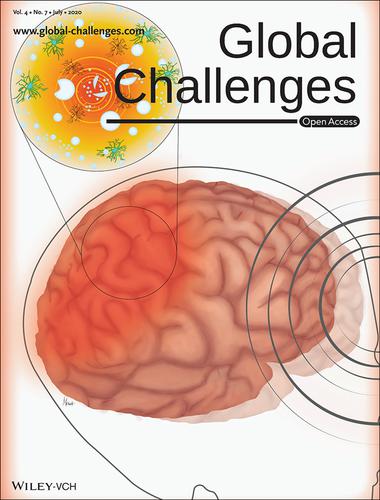当前位置:
X-MOL 学术
›
Glob. Chall.
›
论文详情
Our official English website, www.x-mol.net, welcomes your
feedback! (Note: you will need to create a separate account there.)
Characterization of Astrocytic Response after Experiencing Cavitation In Vitro (Global Challenges 7/2020)
Global Challenges ( IF 4.4 ) Pub Date : 2020-07-02 , DOI: 10.1002/gch2.202070071 Alex H. Wrede 1 , Marilyn C. McNamara 1 , Rodger Baldwin 1 , Jie Luo 2 , Reza Montazami 1 , Anumantha Kanthasamy 2 , Nicole N. Hashemi 1, 2
Global Challenges ( IF 4.4 ) Pub Date : 2020-07-02 , DOI: 10.1002/gch2.202070071 Alex H. Wrede 1 , Marilyn C. McNamara 1 , Rodger Baldwin 1 , Jie Luo 2 , Reza Montazami 1 , Anumantha Kanthasamy 2 , Nicole N. Hashemi 1, 2
Affiliation

|
Low‐pressure regions inside the skull can cause vapor contents in the cerebral spinal fluid to expand and collapse in traumatic brain injury (TBI). Using cell‐laden microfibers, Nicole N. Hashemi and co‐workers visually analyzed the longitudinal morphological response that astrocytes express to surrounding cavitation in vitro. Genetic analytics were conducted post‐cavitation to show drastic upregulation in TBI‐related genes. Astrocytes are known to be neurotoxic after cranial insult, and this study, described in article 1900014, confirms the adverse effects that cavitation has on the astrocytic phenotype.

中文翻译:

经历空化后星形胶质细胞反应的特征(全球挑战7/2020)
颅骨内的低压区域可导致脑脊髓液中的蒸气含量在颅脑外伤(TBI)中膨胀和收缩。Nicole N. Hashemi及其同事使用载有细胞的超细纤维,在视觉上分析了星形胶质细胞在体外对周围空化表达的纵向形态反应。空化后进行了遗传分析,以显示TBI相关基因的急剧上调。已知星形胶质细胞在颅脑损伤后具有神经毒性,文章1900014中描述的这项研究证实了空化对星形细胞表型的不利影响。

更新日期:2020-07-02

中文翻译:

经历空化后星形胶质细胞反应的特征(全球挑战7/2020)
颅骨内的低压区域可导致脑脊髓液中的蒸气含量在颅脑外伤(TBI)中膨胀和收缩。Nicole N. Hashemi及其同事使用载有细胞的超细纤维,在视觉上分析了星形胶质细胞在体外对周围空化表达的纵向形态反应。空化后进行了遗传分析,以显示TBI相关基因的急剧上调。已知星形胶质细胞在颅脑损伤后具有神经毒性,文章1900014中描述的这项研究证实了空化对星形细胞表型的不利影响。












































 京公网安备 11010802027423号
京公网安备 11010802027423号